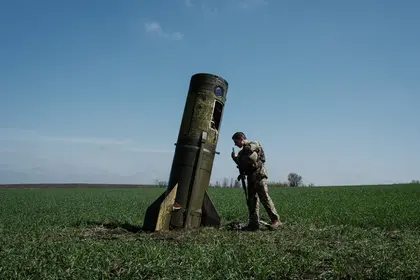Yuriy Ignat, a spokesperson for the Ukrainian Air Force, believes that Russia is preparing to station Iranian ballistic missiles close to Ukraine’s northern border. He said that shooting them down is “possible in theory but very difficult in practice.”
“We’re going to take every defense measure against these missiles. They’ll probably be stationed to the north of Ukraine, and launched in such a way as to threaten the whole of Ukraine. There’s one type of missile with a 300-kilometer range [125 miles], and another with a range of 700 kilometers [425 miles],” Ignat warned.
“These are ballistic missiles. We have no effective defense against them. We have the means of air defense, but not of missile defense,” Ignat explained in his briefing on Nov. 1.
Iran was reportedly about to send its Fateh-110 and Zolfaghar missiles to Russia, according to an earlier report from The Washington Post. Their ranges fall within the distances that Ignat described.
According to Reuters in Moscow on Oct. 6, an agreement was reached regarding the missiles shipment. Kyrylo Budanov, the head of Ukraine’s defense intelligence, has also claimed that Russia would get Iranian missiles in November.
CNN reported that Iran will send Russia about 1,000 weapons, including 450 suicide drones and a number of short-range ballistic missiles according to an unnamed official source in the West. Iran’s involvement in supplying Russia with weapons for its conflict with Ukraine and this information are denied by both Russia and Iran. Nevertheless, the Ukrainian military reports shooting down Iranian drones almost daily.

N. Korean Troops Massed in Russia to Enter Ukraine War ’Soon’: Pentagon Chief
Drones have been used extensively in the conflict ever since Russia began its full-scale invasion of Ukraine in late February. Their use has increased since the summer when the U.S. and Kiev claim Moscow purchased drones from Iran. These Iranian drones have recently been used to attack vital Ukrainian energy infrastructure.
The CNN report claims that Iranian drones have the ability to circle for some time in an area that has been flagged as a potential target before striking and are known as “loitering munitions.” They are lightweight, portable and simple to launch but their main benefit is that they can be fired from a distance and are imperceptible.
Additionally, according to U.S. claims, Iran sent military personnel to Crimea to support Russian drone attacks on Ukrainian targets.
The U.S. National Security Council’s communications coordinator John Kirby stated in October that the presence of Iranian personnel was proof of Tehran’s direct involvement in the conflict.
“We can confirm that Russian military personnel that are based in Crimea have been piloting Iranian UAVs, using them to conduct strikes across Ukraine, including strikes against Kyiv,” Kirby said in reference to uncrewed aircraft.
It is likely that sending more Iranian weapons to Russia will worsen the country’s relations with the U.S.
Rob Malley, the U.S. ambassador to Iran, strongly criticized Iran on Monday, Oct. 31, for providing drones, saying that the Biden administration will not “waste our time” on efforts to resurrect the nuclear agreement “if nothing’s going to happen.”
“We know that those drones have been used to target civilians and civilian infrastructure. And we know that Iran, in the face of all of this evidence, keeps lying and denying that it’s happening,” Malley stated.
Pentagon press secretary Brig. Gen. Pat Ryder told reporters during a briefing on Tuesday, Nov. 1, that “We do have concerns that Russia may also seek to acquire additional advanced munition capabilities from Iran, for example surface-to-surface missiles, to use in Ukraine.”
The U.S. has increased sanctions against Iran as a result of Tehran’s support of Russia in the conflict in the Ukraine and its suppression of nationwide demonstrations following the death of Mahsa Amini, 22, in September.
You can also highlight the text and press Ctrl + Enter






